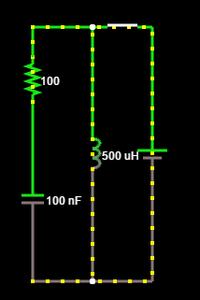Resistanceisfutile
Member level 4
What is wrong with my oscillator?
I'm aware inductive kickback occurs when the current through an inductor is rapidly changed.
I connected a non-polar 0.10uF capacitor in parallel with a 500uH inductor to make a tank circuit and powered it using three 1.5v batteries. This should create a 500Hz pulse.
However, I hear no interference at this frequency which leads me to think it isn't working.
Is there some reason why my circuit wouldn't work - or is it likely I've just connected it up wrong?
I'm aware inductive kickback occurs when the current through an inductor is rapidly changed.
I connected a non-polar 0.10uF capacitor in parallel with a 500uH inductor to make a tank circuit and powered it using three 1.5v batteries. This should create a 500Hz pulse.
However, I hear no interference at this frequency which leads me to think it isn't working.
Is there some reason why my circuit wouldn't work - or is it likely I've just connected it up wrong?

